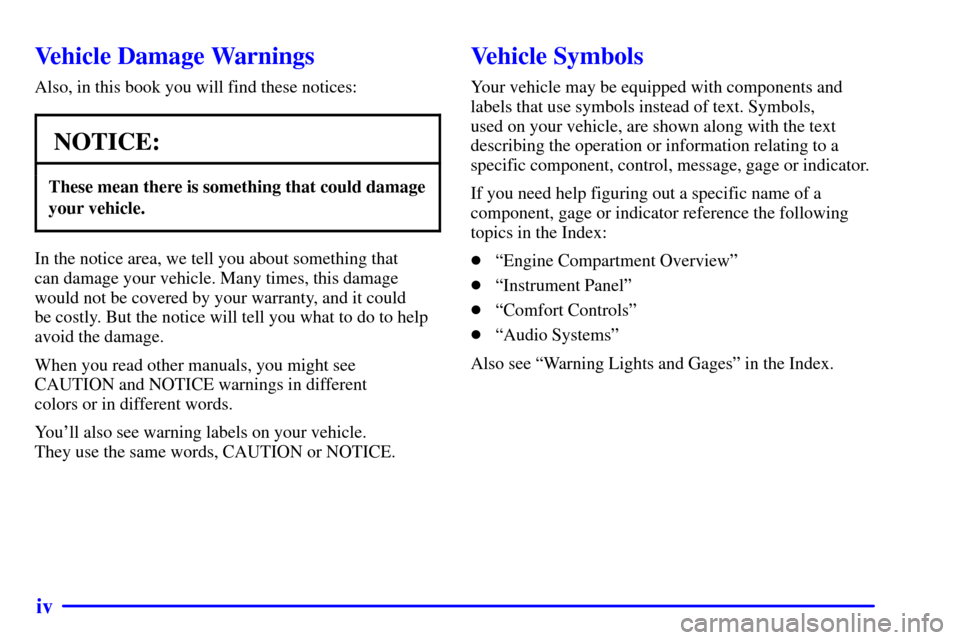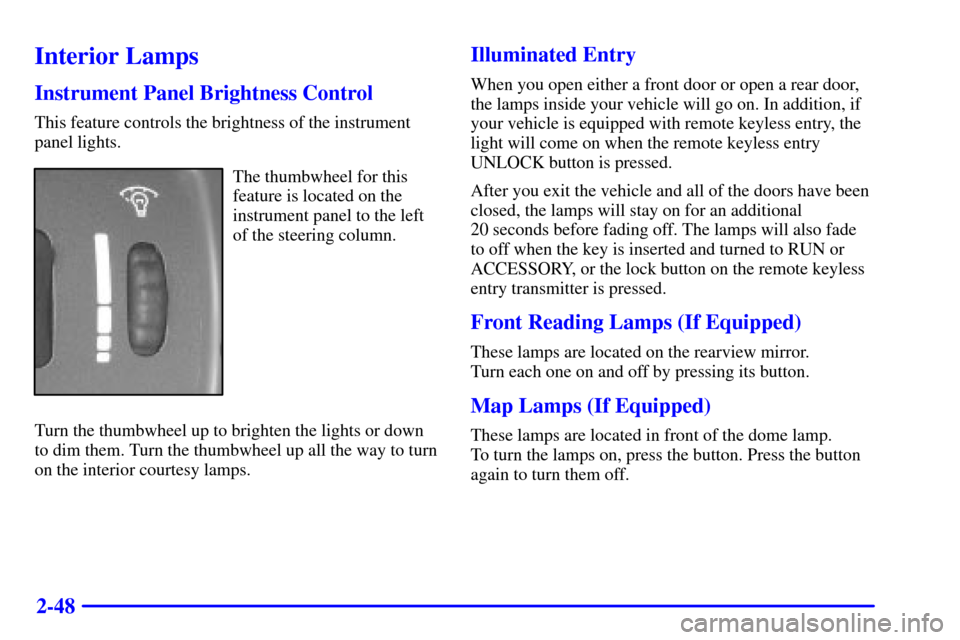Page 5 of 360

iv
Vehicle Damage Warnings
Also, in this book you will find these notices:
NOTICE:
These mean there is something that could damage
your vehicle.
In the notice area, we tell you about something that
can damage your vehicle. Many times, this damage
would not be covered by your warranty, and it could
be costly. But the notice will tell you what to do to help
avoid the damage.
When you read other manuals, you might see
CAUTION and NOTICE warnings in different
colors or in different words.
You'll also see warning labels on your vehicle.
They use the same words, CAUTION or NOTICE.
Vehicle Symbols
Your vehicle may be equipped with components and
labels that use symbols instead of text. Symbols,
used on your vehicle, are shown along with the text
describing the operation or information relating to a
specific component, control, message, gage or indicator.
If you need help figuring out a specific name of a
component, gage or indicator reference the following
topics in the Index:
�ªEngine Compartment Overviewº
�ªInstrument Panelº
�ªComfort Controlsº
�ªAudio Systemsº
Also see ªWarning Lights and Gagesº in the Index.
Page 62 of 360

2-
2-1
Section 2 Features and Controls
Here you can learn about the many standard and optional features on your vehicle, and information on starting,
shifting and braking. Also explained are the instrument panel and the warning systems that tell you if everything is
working properly
-- and what to do if you have a problem.
2
-2 Windows
2
-4 Keys
2
-6 Door Locks
2
-8 Remote Keyless Entry (If Equipped)
2
-13 Trunk
2
-16 Theft
2
-17 Content Theft Security System (If Equipped)
2
-18 Passlock�
2-19 New Vehicle ªBreak-Inº
2
-19 Ignition Positions
2
-22 Starting Your Engine
2
-25 Engine Coolant Heater (If Equipped)
2
-27 Automatic Transaxle Operation
2
-30 Manual Transaxle Operation
2
-33 Parking Brake
2
-34 Shifting Into PARK (P)
(Automatic Transaxle Only)
2
-36 Shifting Out of PARK (P)
(Automatic Transaxle Only)2
-36 Parking Your Vehicle
(Manual Transaxle Models Only)
2
-37 Parking Over Things That Burn
2
-37 Engine Exhaust
2
-38 Running Your Engine While You're Parked
(Automatic Transaxle)
2
-39 Tilt Wheel (If Equipped)
2
-39 Turn Signal/Multifunction Lever
2
-45 Exterior Lamps
2
-48 Interior Lamps
2
-49 Mirrors
2
-52 Storage Compartments
2
-53 Ashtrays and Cigarette Lighter (If Equipped)
2
-53 Sun Visors
2
-55 Sunroof (If Equipped)
2
-56 The Instrument Panel -- Your
Information System
2
-58 Instrument Panel Cluster
2
-60 Warning Lights, Gages and Indicators
Page 78 of 360

2-17
Content Theft Security System
(If Equipped)
Arming the System
With the ignition off, pressing the transmitter LOCK
button will arm the system immediately after all doors
and trunk are closed. If the transmitter LOCK button is
pressed again within five seconds, the horn will chirp to
confirm that the system had been armed.
Once the system is armed, the THEFT SYSTEM light
on your instrument panel will flash and remain flashing.
This confirms the system is armed and monitoring the
doors and trunk. If the light is on solid, the system is
not properly activated due to either a door or the trunk
being ajar.
If you don't want to arm the system, lock the car
with the lock levers on the doors or with the door
lock switch.
Disarming the System
If the system is armed, pressing the UNLOCK button
on the transmitter will disarm the system. The THEFT
SYSTEM light will stop flashing.
If the system is armed, turning the key to START will
also disarm the system.
If the system is armed and the trunk is opened using the
trunk release button on the transmitter, the system will
temporarily disarm itself and rearm when the trunk has
been closed. This allows the customer to exit the
vehicle, lock the doors using the transmitter, and open
the trunk using the transmitter without having to disarm
and subsequently rearm the system.
How the System Alarm is Activated
If the system is armed, opening any door or trunk,
or using a wrong key to start the vehicle will cause a
pre
-alarm chirp for 10 seconds and then a full alarm
of horn and headlights for two minutes.
If an alarm event has finished and all doors and
trunk are closed, the content theft security system
will re
-arm itself.
Page 82 of 360
2-21
D (RUN): This is the position to which the switch
returns, after you start your engine and release the
switch. The switch stays in RUN when the engine is
running. But even when the engine is not running, you
can use RUN to operate your electrical accessories, and
to display some instrument panel warning lights.
E (START): This position starts the engine. When the
engine starts, release the key. The ignition switch will
return to RUN for normal driving.
Even if the engine is not running, the positions
ACCESSORY and RUN allow you to operate electrical
accessories, such as the radio.Key Release Button (Manual Transaxle)
The ignition key cannot be
removed from the ignition
unless the key release
button is used.
To remove the key, turn the key to OFF. Then, while
pressing the key release button in, turn the key to LOCK
and pull it straight out.
Page 107 of 360

2-46
The exterior lamp band has three positions:
OFF: Turning the band to this position turns off all
lamps, except the Daytime Running Lamps (DRL).
(Parking Lamps): Turning the band to this position
turns on the parking lamps, together with the following:
�Sidemarker Lamps
�Taillamps
�Instrument Panel Lights
(Headlamps): Turning the band to this position
turns on the headlamps, together with the previously
listed lamps and lights.
Lamps On Reminder
If you open the driver's door with the ignition off and
the lamps on, you will hear a warning chime.
Daytime Running Lamps
Daytime Running Lamps (DRL) can make it easier for
others to see the front of your vehicle during the day.
DRL can be helpful in many different driving
conditions, but they can be especially helpful in the
short periods after dawn and before sunset. Fully
functional daytime running lamps are required on all
vehicles first sold in Canada.
The DRL system will make your high and low
-beam
headlamps come on at a reduced brightness in daylight
when the following conditions are met:
�The ignition is on,
�the exterior lamp band is in OFF or in the parking
lamp position,
�the parking brake is released, and
�the transaxle is not in PARK (P) on models with an
automatic transaxle only.
Page 109 of 360

2-48
Interior Lamps
Instrument Panel Brightness Control
This feature controls the brightness of the instrument
panel lights.
The thumbwheel for this
feature is located on the
instrument panel to the left
of the steering column.
Turn the thumbwheel up to brighten the lights or down
to dim them. Turn the thumbwheel up all the way to turn
on the interior courtesy lamps.
Illuminated Entry
When you open either a front door or open a rear door,
the lamps inside your vehicle will go on. In addition, if
your vehicle is equipped with remote keyless entry, the
light will come on when the remote keyless entry
UNLOCK button is pressed.
After you exit the vehicle and all of the doors have been
closed, the lamps will stay on for an additional
20 seconds before fading off. The lamps will also fade
to off when the key is inserted and turned to RUN or
ACCESSORY, or the lock button on the remote keyless
entry transmitter is pressed.
Front Reading Lamps (If Equipped)
These lamps are located on the rearview mirror.
Turn each one on and off by pressing its button.
Map Lamps (If Equipped)
These lamps are located in front of the dome lamp.
To turn the lamps on, press the button. Press the button
again to turn them off.
Page 121 of 360
2-60 Tachometer
The tachometer displays the
engine speed in revolutions
per minute (rpm).
NOTICE:
Do not operate the engine with the tachometer in
the red area, or engine damage may occur.
Warning Lights, Gages
and Indicators
This part describes the warning lights and gages that
may be on your vehicle. The pictures will help you
locate them.
Warning lights and gages can signal that something is
wrong before it becomes serious enough to cause an
expensive repair or replacement. Paying attention to
your warning lights and gages could also save you or
others from injury.
Warning lights come on when there may be or is a
problem with one of your vehicle's functions. As you
will see in the details on the next few pages, some
warning lights come on briefly when you start the
engine just to let you know they're working. If you are
familiar with this section, you should not be alarmed
when this happens.
Page 122 of 360
2-61
Gages can indicate when there may be or is a problem
with one of your vehicle's functions. Often gages and
warning lights work together to let you know when
there's a problem with your vehicle.
When one of the warning lights comes on and stays on
when you are driving, or when one of the gages shows
there may be a problem, check the section that tells you
what to do about it. Please follow this manual's advice.
Waiting to do repairs can be costly
-- and even
dangerous. So please get to know your warning lights
and gages. They're a big help.
Safety Belt Reminder Light
When the key is turned to RUN or START, a chime will
come on for about eight seconds to remind people to
fasten their safety belts, unless the driver's safety belt is
already buckled.
The safety belt light
will also come on and stay
on for about 20 seconds,
then it will flash for
about 55 seconds.
If the driver's belt is already buckled, neither the chime
nor the light will come on.